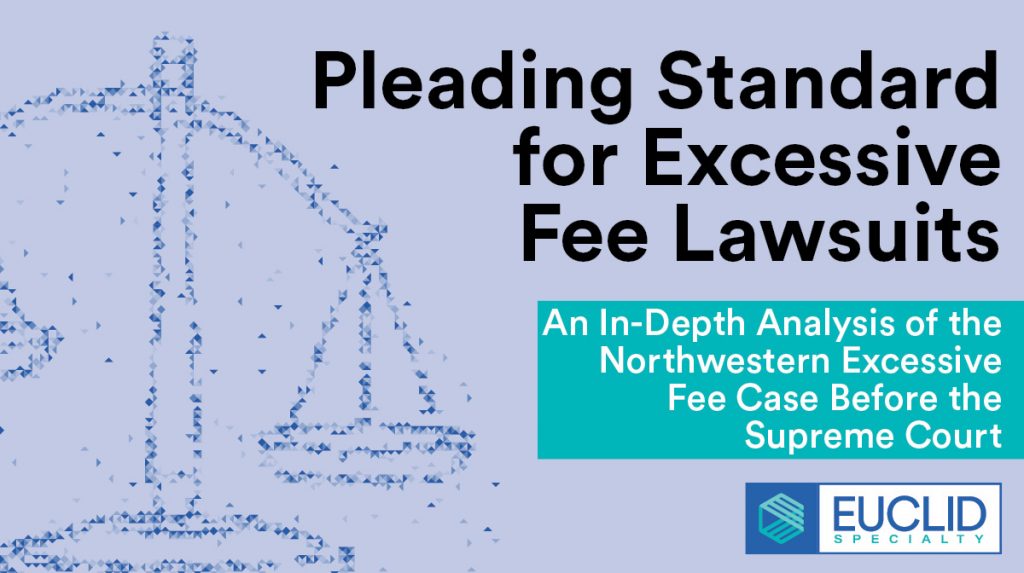Euclid’s new whitepaper analyzes how the Supreme Court should review the Hughes v. Northwestern excessive fee lawsuit in the upcoming Fall term, by establishing a more consistent and rigorous standard to weed out speculative and unsubstantiated claims that the retirement fees for many of America’s largest defined contribution plans are too high.
Euclid Fiduciary Managers, LLC (“Euclid Fiduciary”) released a new whitepaper authored by the underwriting company’s Managing Principal Daniel Aronowitz that explores how courts have applied inconsistent and often arbitrary pleading standards to the over 350 excessive fee lawsuits in the last five years. These lawsuits allege that the fiduciaries of large defined contribution plans have improperly allowed prominent retirement plan recordkeeping and investment firms to overcharge defined contribution plan participants. The Supreme Court has now accepted the Hughes v Northwestern University, et al., No. 19-1401, excessive fee case for review after the Department of Labor filed an amicus brief advocating that the case presented an opportunity for the Court to rule on “the question of what ERISA requires of plan fiduciaries to control expenses” – a question that DOL said “frequently recurs.”
According to Euclid’s whitepaper, “the key issue is what standard or hurdle plaintiffs must satisfy in order to withstand a motion to dismiss.” The pleading standard is critical, because if the case proceeds to expensive discovery, which is more burdensome to the defense [Northwestern says it paid $4m for discovery in just 16 months before its motion to dismiss was decided], plaintiffs gain the upper-hand to drive a settlement based on a high damages model — the differential between what plaintiff lawyers say recordkeeper and investment fees should have been subtracted from what the plan actually paid. Given that most cases currently survive a motion to dismiss — only one-quarter are dismissed at the pleading stage — plaintiffs have been able to leverage substantial settlements against plan sponsors.
The whitepaper explains that the Northwestern case provides the first opportunity for clarity and judicial fairness. According to Euclid’s whitepaper, the Supreme Court needs to provide clarity to reduce expensive and frequent litigation by articulating two principles supported by ERISA fiduciary law, related excessive fee law under the Investment Company Act, and even the briefs of DOL and participant counsel:
(1) that no fiduciary under ERISA fiduciary law should be held liable for breach of fiduciary duty and be forced to spend millions defending their conduct unless the fees are egregious or disproportionately large; and
(2) to properly allege whether fees are egregious, plaintiffs must allege a reliable benchmark of materially identical investments or services, demonstrating that no prudent fiduciary would have made the same decision.
As the whitepaper analyzes, this more rigorous test would weed out the many meritless excessive fees cases currently being filed against plan sponsors. It would require dismissal of challenges to small fee differentials, and would require plaintiffs to substantiate their claims by comparing claims of excessive fees against reliable alternative investments and services that are materially identical. By contrast, in many cases being allowed to proceed to expensive discovery, plaintiffs are asserting unsubstantiated benchmarks and comparing actively managed funds to passive investments that have completely different investment strategies and cost structures. Even DOL’s amicus brief requires a higher pleading standard in which fiduciaries are liable for breach of fiduciary duty if lower investment fees are available for “materially identical investments.”
To learn more, download the Whitepaper “The Pleading Standard for Excessive Fee Lawsuits, An In-Depth Analysis of the Northwestern Excessive Fee Case Before the Supreme Court” or visit our website at www.euclidspecialty.com.



